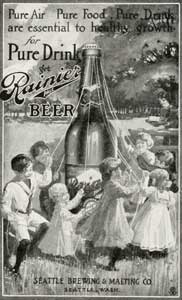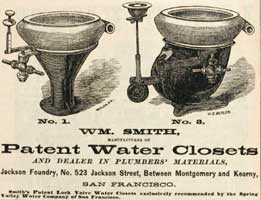Early Advertising of the West, 1867-1918
Sample Searches
- African Americans
- Automobiles, carriages & wagons
- Banking & finance
- Beauty & fashion
- Child rearing & care
- Clothing trade
- Commercial & professional services
- Commercial products
- Cosmetics & perfumes
- Cost & standard of living
- Education & schools
- Entertainment & leisure activities
- Farm machinery
- Hair products & toiletries
- Health & hygiene
- Health resorts, sanatoriums & spas
- Home economics, household goods & appliances
- Hotels & restaurants
- Inventions & investment opportunities
- Klondike Gold Rush
- Liquor, wine & beer
- Machinery, equipment & appliances
- Medical instruments & devices
- Native Americans
- Nature & the environment
- Naturopathy
- Newspapers & magazines
- Nutrition & food
- Patriotism
- Prohibition
- Psychology & mental health
- Publishing industry
- Quackery
- Railroad travel
- Real estate & land development
- Religion & spiritual life
- Saving & investment
- Social conditions & politics
- Sports & outdoor activities
- Steamships, ferries & boats
- Time schedules
- Tobacco
- Tourism & travel
- Transportation & communication
- Women's issues
The Early Advertising of the West collection consists of over 450 print advertisements published in local magazines, city directories, and theater pamphlets from 1867 to 1918. These advertisements were selected and digitized in order to help researchers and students examine social, cultural and economic trends during this period. The collection is categorized into thematic groups and features advertisements about health care and hygiene products, liquor, tobacco, machinery, manufacturing, transportation, fashion, food and household goods and local tourism. Due to the lack of government drug inspection and regulation during this era, patent medicines and medical treatments such as tonics, tablets and electrical body belts are well represented.
Many of the advertisements shed light on the history and social conditions of the Pacific Northwest. In particular, they contain information regarding real estate, cost and standard of living, schools, and tourist destinations in Washington and Oregon. Some advertisements document the marketing efforts of local companies like Rainier Beer and The Bon Marche. In addition, the collection touches upon important historical issues such as the Washington state prohibition movement, the 1897 Alaskan Gold Rush and regional railroad construction. It also provides examples of race and gender based stereotypes commonly used by advertisers.
A Brief History of American Advertising: From the end of the Civil War to the beginning of World War I
Since advertisements first appeared in colonial newspapers in the early eighteenth century, the American advertising industry has expanded to promote a proliferation of products and services. Much of its development has been influenced by war, westward migration and technological advancement.
The Civil War spurred the growth of print advertising for many reasons. The conflict created a need for hundreds of thousands of uniforms, underwear and shoes and ready-made food which triggered mass production of clothing and canned goods. In addition, when men went off to war, women went to work in the factories to earn money. With less time to make bread, soap and clothing for their families, women used their earnings to purchase goods from stores and bakeries. This rise in consumerism was accompanied by the invention of wood pulp newsprint, new publishing techniques (curved stereotype press), and innovations in techniques used to reproduce illustrations.
Meanwhile, Americans were moving in droves to the Western frontier. Waves of migrants were inspired by the promises of cheap land and riches, due to the Homestead Act of 1841 and the California Gold Rush in 1848. Following the completion of the first transcontinental railroad in 1869, the journey west became considerably easier. Many entrepreneurs and private companies began heavily advertising real estate, investment and tourism opportunities on the West Coast. In the cities and towns of the Pacific Northwest, businesses rallied around the Alaskan Gold Rush of 1897. Mass-produced food and supplies were marketed toward gold speculators. Railroads revolutionized the transportation of goods providing American consumers with more products and services to choose from at local stores and businesses.
As wagons and trains moved west and steamers traveled north to Alaska, businesses turned to magazines as well as newspapers to publicize their goods. Entrepreneurs such as Henry J. Heinz and Dr. W.K. Kellogg began to trademark and package their foods. To distinguish their goods from competitors’ wares, companies created characters (Aunt Jemima and Buster Brown) and slogans (like Ivory Soap’s “It Floats!”). An increase in branding coincided with the influx of new technologies, including Kodak cameras, Bell telephones, Edison phonographs and Detroit Electric automobiles. By the beginning of World War I, long before the rise of radio and television advertising, many brands had achieved national recognition and were available on the local market.
About the Database
The information for the Early Advertising of the West collection was researched and prepared by the UW Libraries Special Collections Division in 2008. The advertisements in this database were selected from materials from various book and theater program collections held at the UW Libraries Special Collections Division. The images were scanned on a flatbed scanner or captured with a digital camera from originals as TIFF files, manipulated in Adobe PhotoShop to achieve the best and clearest possible digital image and loaded into the Contentdm JPEG2000 software and linked with descriptive metadata. Selection for the Early Advertising Collection was done by Kristin Kinsey and the research and descriptive metadata was prepared by James Hancock.
Bibliography
Goodrum, Charles, and Helen Dalrymple. Advertising in America: The first 200 years. New York: Harry N. Abrams, 1990.
McDonough, John, and Karen Egolf. The Advertising Age Encyclopedia of Advertising. New York: Fitzroy Dearborn, 2003.
Norris, James. Advertising and the transformation of American society, 1865-1920. New York: Greenwood Press, 1990.
O'Barr, William. Culture and the ad: Exploring otherness in the world of advertising. Boulder, Colo.: Westview Press, 1994.
Presby, Henry. The history and development of advertising. Garden City, N.Y.: Doubleday, 1929.
Sivulka, Juliann. Soap, sex and cigarettes. Belmont, Ca.: Wadsworth Pub. Co., 1998.
Online bibliography
Ad* access. 25 Jan. 2008. John W. Hartman Center for Sales, Advertising & Marketing History: Duke University Rare Book, Manuscript, and Special Collections Library. 29 May 2008 http://library.duke.edu/digitalcollections/adaccess/
An American time capsule: Three centuries of broadsides and other printed ephemera. 19 Mar. 2008. Library of Congress American Memory. 29 May 2008 (site archived in 2014)
Emergence of advertising in America. 4 Feb. 2008. John W. Hartman Center for Sales, Advertising & Marketing History: Duke University Rare Book, Manuscript, and Special Collections Library. 29 May 2008 http://library.duke.edu/digitalcollections/eaa/



